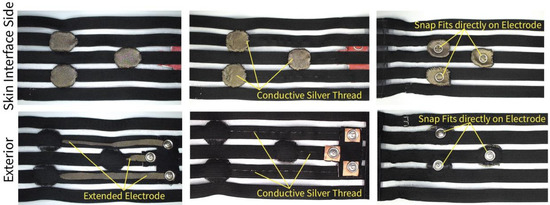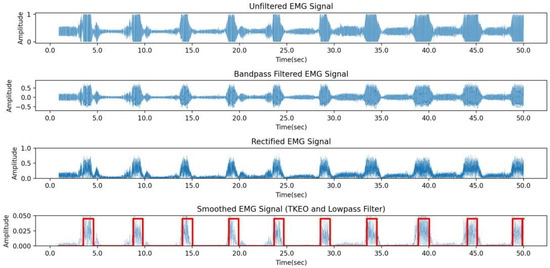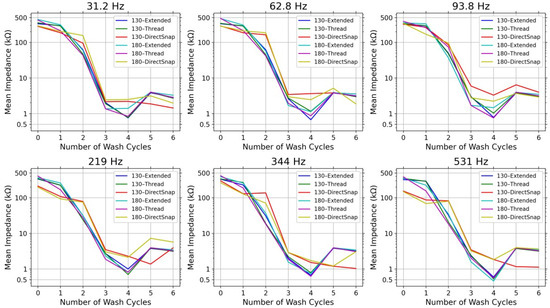Abstract
This research paper recommends an electrode construction and integration technique for dry silver-based textile electrodes capturing electromyographic (EMG) signals. Three integration methods with two different conductive textiles were compared using two analysis methods; analysis was also conducted before and after six washing cycles. Six wearable arm bands with each of the design parameter combinations were worn on the biceps brachii muscle to capture EMG signals from three users under a controlled task both before any washing of the bands occurred and after four washing cycles were completed. Additionally, impedance measurements over six frequency bands were recorded after each washing cycle. Textile electrodes made of Shieldex Techniktex P180B using an extended electrode integration method were found to perform best.
1. Introduction
Published design guidelines are not available for makers who want to use dry silver textile electrodes for non-medical EMG applications within a human–computer interaction context. This work focuses on design recommendations for silver fabric electrode integration in wearable product design. The drawbacks of wet electrodes including user discomfort, setup time and unsustainable limited reuse [1,2] further propel the need for guidelines regarding the appropriate construction of dry electrodes. Furthermore, research outputs rarely evaluate integration techniques, only stating the connection material but not how the connection is made [3].
2. Materials and Methods
2.1. Fabric Construction Types
Silver fabric was chosen as the electrode material because of its good signal quality across biopotential types [4]. Two commercially available silver fabrics were examined: Shieldex Techniktex P130B and P180B.
2.2. Electrode Sizing and Placement
Electrodes were cut to 20 mm by 25 mm. SENIAM guidelines were followed for electrode placement decisions [5]. Two main electrodes were situated parallel to the biceps brachii muscle fibers with an inter electrode distance of 20 mm. For samples with extended textile electrodes and sewn conductive thread, a reference electrode was placed 50 mm away from the muscle. For samples with integrated direct snap fits, the reference electrode position was constrained by the reach of the EMG sensor PCB.
2.3. Integration Techniques
Three integration types were considered: extending the electrode material to a snap fit, sewing silver conductive thread to connect to a snap fit, and directly placing a snap fit on the electrode. Six samples were created, covering all combinations of fabric and integration types. Figure 1 shows how each integration technique is implemented into a stretchable armband.

Figure 1.
Electrode integration techniques showing connection to snap fit within wearable armband.
2.4. Experimental Design
Each sample underwent six wash cycles at 40 °C and open-air drying [6]. EMG data were collected twice, once pre-wash and once after four wash cycles. Electrode contact impedance data were collected across six frequencies both pre-wash and after all six wash cycles.
2.4.1. EMG Testing
EMG data were collected at 1000 Hz from three adults for all six samples with participants performing simple bicep curl exercises with a self-selected weight ranging from one to four kilograms. The exercise was completed with participants seated in an upright position, commencing with their arm resting flat on a table, palm facing upward. To ensure the consistency and accuracy of the exercise, a metronome was employed to guide the participants through ten repetitions of the curl exercise, with each repetition lasting five seconds.
Unfiltered EMG signals were processed following the steps shown in Figure 2. Filtering frequencies were selected to reduce noise stemming from multiple sources including electrode motion artifacts, ECG artifacts, and power line interference [7].

Figure 2.
System diagram of signal processing steps.
Figure 3 shows how processing steps affected the signal.

Figure 3.
EMG signal example showing how processing steps affect the signal.
2.4.2. Contact-Impedance Testing
An eliko Quadra Impedance Spectroscopy device was used to record electrode contact-impedance data across six frequency bands: 31.2, 62.8, 93.8, 219, 344 and 531 Hz. Alligator clamps connected the snap fits to the device for the readings. After each wash cycle, we recorded fifty samples at 32 Hz from each frequency band for every armband.
3. Results
3.1. EMG
The goal was to identify which samples have clear peaks and a threshold that can be used to classify muscle activation states. Figure 4 shows an example of a processed EMG signal with clear peaks and an example with indiscernible peaks. Samples were ranked on a system based on peak clarity. The top three samples were 130-Extended, 180-Extended and 180-Thread, each resulting in clear peaks for at least two participants both pre and post four wash cycles. Only 180-Extended achieved an SNR above 10 dB for all participants.

Figure 4.
Example of processed signals’ clear peaks with muscle activation state in red (top) and where clear muscle activation cannot be clearly observed (bottom).
3.2. Contact-Impedance
Figure 5 shows contact-impedance values were in an expected EMG range [8] and generally decreased for all samples with consecutive washes with a marked drop after the third wash cycle. Fabric stability is typically reached after six wash cycles [9] and all samples generally appear to start stabilizing after sixth wash. The Shieldex fabrics utilized in this study were not recently acquired, which could contribute to the higher initial impedance values observed. Although the behavior of direct snap fit integration varied from the others after the second, fourth and fifth washes, the limited number of wash cycles prevents further conclusions.

Figure 5.
Plots of mean contact-impedance after each wash cycle for all samples at relevant frequencies.
4. Discussion
Sample 180-Extended was the best-performing sample with clear peaks before and after four wash cycles and was the only sample to have a good-quality SNR. Hence, for designers wanting to use EMG sensing with silver textile electrodes in interactive systems, we recommend prototyping with Shieldex Techniktex P180B or a textile with similar properties and integrating it by extending the textile instead of using sewn conductive thread or directly integrating a snap fit into the electrode. We further recommend washing the textile before use but cannot make recommendations on how subsequent long-term wear and washing will affect performance.
Author Contributions
Conceptualization, R.J.D. and R.S.; methodology, R.J.D.; formal analysis, R.J.D. and Z.L.; wearable development, R.J.D. and X.M.; writing—original draft preparation, R.J.D.; writing—review and editing, R.S.; supervision, R.S.; All authors have read and agreed to the published version of the manuscript.
Funding
This research received no external funding.
Institutional Review Board Statement
Ethical review and approval were waived in accordance to Imperial College London procedures because all data collection came from the study authors.
Informed Consent Statement
Informed consent was obtained from all subjects involved in the study.
Data Availability Statement
The data presented in this study are available on request from the corresponding author. The data are not publicly available due to privacy of the participants.
Conflicts of Interest
The authors declare no conflicts of interest.
References
- Yang, L.; Gan, L.; Zhang, Z.; Zhang, Z.; Yang, H.; Zhang, Y.; Wu, J. Insight into the Contact Impedance between the Electrode and the Skin Surface for Electrophysical Recordings. ACS Omega 2022, 7, 13906–13912. Available online: https://www.ncbi.nlm.nih.gov/pmc/articles/PMC9088920/ (accessed on 14 August 2023). [CrossRef] [PubMed]
- Searle, A.; Kirkup, L. A direct comparison of wet, dry and insulating bioelectric recording electrodes. Physiol. Meas. 2000, 21, 271–283. Available online: https://iopscience.iop.org/article/10.1088/0967-3334/21/2/307 (accessed on 14 August 2023). [CrossRef] [PubMed]
- Alizadeh-Meghrazi, M.; Ying, B.; Schlums, A.; Lam, E.; Eskandarian, L.; Abbas, F.; Sidhu, G.; Mahnam, A.; Moineau, B.; Popovic, M.R. Evaluation of dry textile electrodes for long-term electrocardiographic monitoring. Biomed. Eng. Online 2021, 20, 68. [Google Scholar] [CrossRef] [PubMed]
- Lam, E.; Alizadeh-Meghrazi, M.; Schlums, A.; Eskandarian, L.; Mahnam, A.; Moineau, B.; Popovic, M.R. Exploring textile-based electrode materials for electromyography smart garments. J. Rehabil. Assist. Technol. Eng. 2022, 9, 20556683211061995. Available online: https://www.ncbi.nlm.nih.gov/pmc/articles/PMC8811440/ (accessed on 14 August 2023). [CrossRef] [PubMed]
- SENIAM. Recommemdations for Sensor Locations in Arms or Hands. Available online: http://seniam.org/bicepsbrachii.html (accessed on 14 August 2023).
- Vervust, T.; Buyle, G.; Bossuyt, F.; Vanfleteren, J. Integration of stretchable and washable electronic modules for smart textile applications. J. Text. Inst. 2012, 103, 1127–1138. [Google Scholar] [CrossRef]
- McManus, L.; De Vito, G.; Lowery, M.M. Analysis and Biophysics of Surface EMG for Physiotherapists and Kinesiologists: Toward a Common Language with Rehabilitation Engineers. Front. Neurol. 2020, 11, 576729. Available online: https://www.frontiersin.org/article/10.3389/fneur.2020.576729/full (accessed on 14 August 2023). [CrossRef] [PubMed]
- Ravichandran, V.; Ciesielska-Wrobel, I.; Rumon, M.A.A.; Solanki, D.; Mankodiya, K. Characterizing the Impedance Properties of Dry E-Textile Electrodes Based on Contact Force and Perspiration. Biosensors 2023, 13, 728. Available online: https://www.mdpi.com/2079-6374/13/7/728 (accessed on 14 August 2023). [CrossRef] [PubMed]
- Gore, S.E.; Laing, R.M.; Wilson, C.A.; Carr, D.J.; Niven, B.E. Standardizing a Pre-Treatment Cleaning Procedure and Effects of Application on Apparel Fabrics. Text. Res. J. 2006, 76, 445–464. [Google Scholar] [CrossRef]
Disclaimer/Publisher’s Note: The statements, opinions and data contained in all publications are solely those of the individual author(s) and contributor(s) and not of MDPI and/or the editor(s). MDPI and/or the editor(s) disclaim responsibility for any injury to people or property resulting from any ideas, methods, instructions or products referred to in the content. |
© 2024 by the authors. Licensee MDPI, Basel, Switzerland. This article is an open access article distributed under the terms and conditions of the Creative Commons Attribution (CC BY) license (https://creativecommons.org/licenses/by/4.0/).